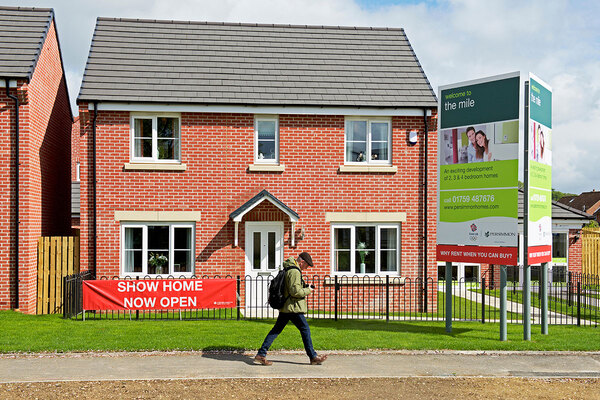We need a housing system designed to meet people’s housing needs, not investment demands
As part of the #PlanForHousing campaign, UCL professor Josh Ryan-Collins reflects on possible interventions in the demand side of the housing market
Labour has set out ambitious and much-needed plans for the housing market. In particular, the reforms to increase security in the private rental sector (PRS) and plans to invest more in social housing are welcome.
But the government appears wedded to the idea that the central problem of the UK housing market is a lack of new supply. There are big questions around whether its target of 1.5 million new homes over the course of this parliament is achievable, given the fact that private sector developers lack incentives to build out at a rate that would reduce their profit margins.
Furthermore, recent research suggests such a programme is not compatible with the UK’s carbon-emissions targets.
Given this, more policy attention needs to be given to the demand side of the equation and how to do more with existing stock. The UK housing market has experienced a structural shift over the past four decades towards favouring housing’s role as an investment. This has impinged on its more fundamental role in meeting people’s needs for adequate shelter. We now have an extraordinarily polarised market.
Owner-occupiers lucky enough to have purchased property before the mid-1990s have become very wealthy and well-housed. Today, 90% of underoccupied households – where there are two or more spare bedrooms – are owner-occupiers. This compares with just 6% of private renters and 4% of social renters.
In contrast, most of the population under the age of 30 are permanently shut out of homeownership and face record-high housing costs in an insecure and, in many cases, poor-quality PRS. Since the early 2000s, mortgaged homeownership has fallen drastically from 45% to 30%, mirrored by the PRS share doubling from 10% to 20%. Private landlords now own around one out of five homes in Britain, while four in 10 adults own no property at all.
The high interest rates of the past few years have led to increased competition in the PRS, as would-be first-time buyers have been priced out of homeownership, inevitably resulting in higher rents.
“Most of the population under the age of 30 are permanently shut out of homeownership and face record-high housing costs in an insecure and, in many cases, poor-quality private rented sector”
These developments were not inevitable. It was the result of policy choices that shaped the housing market: a shift away from subsidising the provision of affordable housing and towards subsidising the demand for homeownership and a liberalised PRS.
The liberalisation of the mortgage market in the 1980s and the creation of buy-to-let mortgages in the late 1990s led to mortgage credit outstanding quadrupling from 20% of GDP in the mid-1980s to 60% by 2007. This flood of capital mainly went into existing property, inevitably inflating prices. While, initially, this helped more people access homeownership, this peaked by the early 2000s as prices soared above incomes.
This credit bubble eventually exploded in 2007, but the record-low interest rates that followed created a quick recovery in prices, as property in major English cities became a globally desirable investment asset.
The recent rise in interest rates has discouraged some types of investor, in particularly mortgaged buy-to-let landlords. However, there is little evidence of an overall decline in investment demand for UK properties, with evidence instead of cash buyers and asset managers buying up housing, including foreign buyers.
Wealthier investors may view property in cities such as London and Manchester as a good long-term investment and be less sensitive to small price changes caused by either rising interest rates or tax reforms.
The 2% increase in stamp duty on second homes announced in the Budget may not be enough to put such investors off.
Fundamentally, the UK housing market is characterised by a housing-finance feedback cycle, whereby increasing financial flows into housing generate rising prices and expectations of future rises, which in turn generate more speculative demand for housing as an investment and so on. Policymakers need to carefully consider what types of interventions can break this powerful dynamic. Marginal reforms in discrete policy spheres are unlikely to do so.
Much more focus needs to be placed on making better use of existing stock. Incentives should be given for homeowners to downsize, with higher taxes on under-occupation and reductions in stamp duty to encourage transactions. New homes may be needed in areas attractive for older people.
Labour should revisit its decision not to raise capital gains charges on additional dwellings. Even if this might not raise huge amounts of money for the Treasury, it would help repress speculative investment demand and hopefully encourage more investment to more-productive parts of the economy.
“Fundamentally, the UK housing market is characterised by a housing-finance feedback cycle”
The biggest tax distortion of all applies to primary residences, of course, where council tax has not been revalued since 1991, there is no capital gains and no imputed rent tax. This has made homeownership by far the most tax-efficient way of investing wealth.
Addressing this huge tax break for owner-occupiers appears a political no-go area. But more consideration should be given to comprehensive reform of the UK property tax system, such as scrapping stamp duty and council tax and replacing them with an annual property tax on the value of homes. This would rebalance the tax burden away from poorer areas of the country and on the South East, which has enjoyed the greatest windfall gains in the past few decades.
A number of cities and regions in high-income economies are turning to the planning system to rebalance the housing market in favour of people’s needs. In cities like Amsterdam and Barcelona, local governments are preventing the conversion of homes into short-let properties, recognising that this is directly contributing to housing pressure. Wales is doing something similar and ramping up council tax on second homes to punitive levels. England should do the same.
There is also potential in giving local authorities and other social landlords or community housing associations greater powers and funding to convert existing properties into affordable homes. They could be given right of first refusal to buy and, where needed, renovate PRS properties that buy-to-let investors may choose to sell, or where landlords are unwilling to upgrade rental properties to the Decent Homes Standard, as is also happening at scale in Barcelona.
This should be one part of a wider plan for a national retrofit of the public and private housing stock that will reduce energy costs, create jobs and ensure the UK stays within its carbon budget.
Local authorities could also be given new compulsory purchase powers to buy early-stage private sector developments that have been delayed, at prices that would render the existing permission viable at minimal profit margins, and convert these to social rented housing.
These interventions will require financial support from government. Homes England could consider raising the 10% acquisitions cap on the Affordable Homes Programme and, in the longer term, by the creation of a public housing corporation/bank. The new fiscal rules announced by chancellor Rachel Reeves mean the financial liabilities of such a corporation – for example, equity holdings in a local authority-owned housing company – would not count against the public sector deficit.
Finally, the mortgage sector also needs major reform. Compulsory and permanent mortgage insurance and longer-term fixed-rate mortgages for first-time buyers should be introduced to bring down the cost of higher loan-to-value (LTV) first-time buyer mortgages.
Alongside this, the Treasury and the Bank of England or the Financial Conduct Authority should consider lowering LTV ratios for buy-to-let mortgages to reduce the volatility of the mortgage and housing market and repress speculative demand during upturns or when interest rates are low. This could further free up housing for first-time buyers.
None of this is to say that more supply is not needed, especially in cities. But prioritising the right to housing as a place to live rather than an investment is the key to addressing the structural crisis in the UK’s housing market.
Josh Ryan-Collins, professor of economics and finance, UCL Institute for Innovation and Public Purpose
Sign up for our homelessness bulletin
Already have an account? Click here to manage your newsletters













